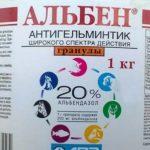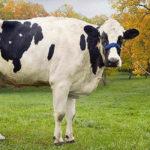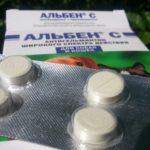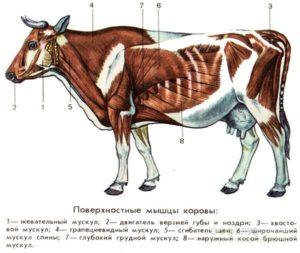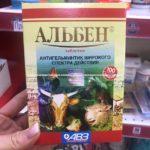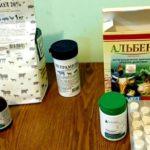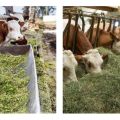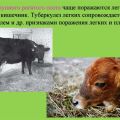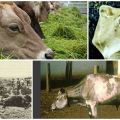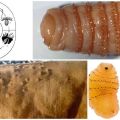Instructions for use and composition of Albena for cattle, dosage and analogues
Alben is a pharmacological agent used to cleanse an animal's body from parasitic worms - nematodes and cestodes. The drug is suitable for farm animals, including cows, goats, pigs. Instructions for using Albena for cattle include not only the mechanism of using the drug, but also possible side effects and dosage.
Composition and pharmacological properties
The composition of the tablets includes the main active ingredient - albendazole. The substance disrupts carbohydrate metabolism in the worm's body, which is why the nematode cannot reproduce and continue to live. Gradually, the parasites die and are removed from the body. It works not only on round, but also on flat worms. Often used for animals grazing on wet pastures, especially susceptible to the influence of parasites.
In what cases are used
Alben has a wide spectrum of action against all kinds of round and flat parasitic worms. It acts not only on nematodes that affect the stomach or intestines, but also on their pulmonary forms. It is used not only for cattle, but also for other ruminants and carnivores, including in the fight against hookworm and toxocariasis.
Pulmonary nematodes
Nematodes penetrate not only into the intestines, but also into the upper respiratory tract, and from there into the lungs. This causes pulmonary nematodosis, which leads to the death of cattle without proper treatment. Pulmonary nematodesis includes dictyocaulosis, which affects ruminants. Cows become infected at a watering hole or on too wet pasture. Eggs and larvae are excreted in the faeces, which contaminates the entire herd.
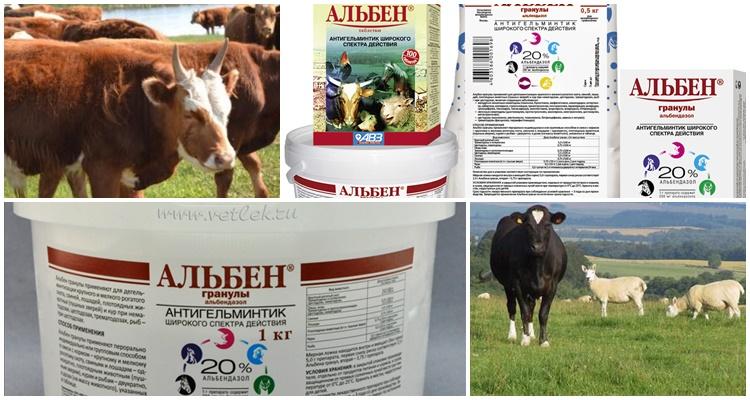
The causative agents of protostrongylosis also settle in the lungs, which are fixed in the bronchi and large alveoli. Typical signs of the disease include shortness of breath, shortness of breath, and poor weight gain. It is possible to diagnose the presence of helminths only after examining feces.
Gastrointestinal nematodes
Gastrointestinal nematodes are considered the most common parasitic worms. Most often, cows develop ascariasis or toxocariasis. Young animals have a hard time tolerating the presence of a worm in the body.
The farmer can identify the disease by the slow weight gain of young animals, reluctance to feed, lack of physical activity.
Elimination of cestodosis
Cestodoses often affect waterfowl. Hymenolepiasis of ducks or geese is one of the most common parasitic diseases.However, cestodes can also be found in cattle with diseases of moniesiasis, thysanesiosis and other pathologies.
Fight against trematodes
Trematodes parasitize the gastrointestinal tract and liver, causing severe poisoning of the body. Without proper treatment, a cow with trematosis will never produce enough milk. Bulls do not gain weight, and young animals do not meet the age norms for growth.
Rules of use and dosage
The dosage of the drug should be calculated based on the type of animal and its weight. For calves, the indicated dosages are divided by two and tablets are given dissolved in water or milk. For other animals: cows, sheep and horses - tablets are given whole or crushed.
| Kind of animal | Dose for use based on 100 kg of live weight |
| Cattle | 3.75 g |
| Sheeps | 2.5 g |
| Pigs | 0.75 g. |
| Horses | 3.75 g |
| Domestic bird | 0.5 g per 10 kg |

Doses are indicated for the prevention of helminth infection. If the disease is already in the active phase, then the indicated doses must be multiplied by two.
Are there any contraindications?
The drug is not recommended to be given to pregnant animals, especially in the first trimester, to calf cows, and also to newborn calves. Emaciated or infectious animals are also at risk, so the use of an anthelmintic agent is limited. The effect of the drug on horses has not been sufficiently studied.
Side effects
When using the substance at a strictly indicated dosage, side effects in animals are not observed. In case of an overdose, there may be vomiting, diarrhea, convulsions similar to epileptic seizures, indigestion and nervous system disorders. An overdose is dangerous for the life of the animal, so you need to call a veterinarian as soon as possible, if possible, flush the stomach and intestines of the cow.
special instructions
After using the drug, animal meat can be eaten only 20 days after the last tablet was given. The use of poultry meat is allowed after 5 days due to the increased metabolic rate. If the animal was forced to be slaughtered earlier than the specified time, you can send the received meat products to feed dogs or cats.
If the drug was used in water for deworming fish, fishing in the reservoir is allowed only 18 days after using the anthelmintic substance.
Storage conditions and periods
The maximum shelf life is 2 years from the date indicated on the package. The opened bottle must be used within 14 days. The tablets are stored out of the reach of animals and children. Do not allow direct sunlight or sudden changes in air temperature. Moisture has a detrimental effect on the packaging and leads to a change in the chemical properties of the drug.
Analogs
According to the active substance, Albena's analogues include Albentabs, which is a tablet with a specific odor. One tablet contains 250 mg of albendazole. Suitable for almost all types of pets and farm animals.

